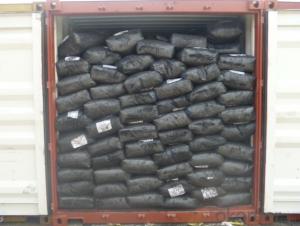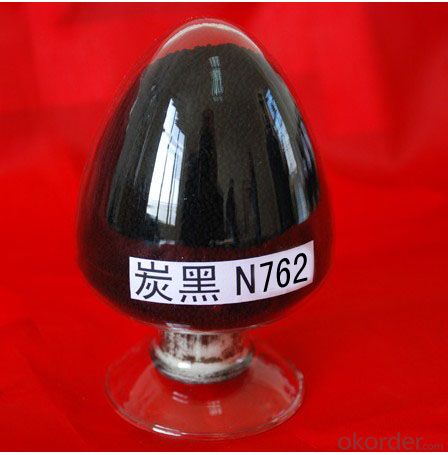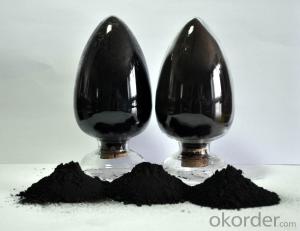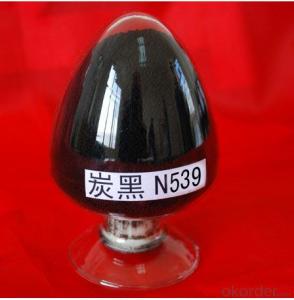Carbon Black N762 Granluar
- Loading Port:
- Tianjin
- Payment Terms:
- TT OR LC
- Min Order Qty:
- -
- Supply Capability:
- 10000MT m.t./month
OKorder Service Pledge
OKorder Financial Service
You Might Also Like
Carbon Black N762 (Granule)
Product Description:
carbon black N762:
1.Usage Rubber Auxiliary Agents;
2.Product Status:Black powder or granular;
3.Standard: ISO 9001:2000
Suggest for Use:
uses for the truck tire, passenger tire tread rubber, etc., and require high strength, high wear-resistant rubber products, such as high-strength conveyor belt, industrial rubber products.
TDS of the Carbon Black N762
Product Varieties | N762 | Pouring density(kg/m3) | 475~555 |
Iodine absorption Value(g/kg) | 23~31 | 300%modulus(Mpa) | -5.9~3.9 |
DBP absorption Value (10-5m2/kg) | 61~69 | Ash content | ≤0.7% |
24Mn DBP(10-5m2/kg) | 55~63 | 45um sieve residue | ≤0.05% |
CTAB surface area(103m2/kg) | 25~33 | 500um sieve residue | ≤0.001% |
STSA/(103m2/kg) | 23~33 | Impurity | NO |
Nsa surface area(103m2/kg) | 26~32 | Fine content | ≤10% |
Tint strength(%) | ---- | Tensile strength(Mpa ) | ≥-5.0 |
Heatloss(%) | ≤1.5 | Elongation at failure | ≥-20% |
Safety:
As a matter of good industrial hygiene, gloves and safety glasses with side shields or better eye protection should be worn when handing Carbon Black ,For more information, refer to the MSDS.



- Q: Does a catalyst work for both reactants and products?From my understanding, organic catalyst or enzyme does not necessarily work for the product of the reaction because of the shape of the activation site. However I cannot speak for inorganic ones.
- A catalyst works for either the reactants or the product in a given reaction. If it works for the reactants then the activation site on the enzyme, for example, will only fit on the reactants. If a catalyst is added to a reaction in which it catalyzes the back-reaction, or it aids the products, then the reaction will be reversed. i don't think a catalyst could work for both the reactants and products in one reaction because it wouldn't really be a catalyst anymore; it wouldn't make the rxn progress any faster since it would be canceling out itself by aiding both the reactants and the products. I think this is what you are asking, if not please post more details. I hope I didn't confuse you even more!
- Q: What is a catalyst in a chemical reaction?
- A catalyst is a compound in chemistry (it can be an acid or temperature or a base or a metal or anything, pressure anything) that shifts the reaction towards one product or the other... In simple words. If you want to obtain something, e.g. water, then you can obtain it in different timings, ie in 2000 years, but if you want to obtain it in 2 hours instead of 2000 years then you add a catalyst, e.g. you heat the reaction to speed it up, you add an acid, or a base etc. Some catalysts also act on the regioselectivity of a compound thru preferring the formation of a stereo-isomer to another. E.g. if you want to obtain S-Thalidomide instead of R-Thalidomide you use a particular catalyst etc...
- Q: Co and No form a chemical equation for Co2 and No2 under the action of a catalyst
- Write the catalyst on the horizontal line, where NO is the oxidant and CO is the reducing agent
- Q: What is the chemical nature of the enzyme?
- The difference between the enzyme and the general protein is that the enzyme is a protein with a special catalytic function. Similarly, the enzyme, like other proteins, consists mainly of amino acids, with one, two, three and quaternary structures, and the same enzyme as other proteins The composition of the enzyme can be divided into two types: simple protein and binding protein. Some enzymes are only protein, its activity depends on its protein structure, such enzymes are simple protein; other enzyme active ingredients in addition to containing protein, but also There are some small molecules that cofactor, the two together to be active, such enzymes belong to the binding protein.The protein part of the protein is called the enzyme protein, non-protein part called the cofactor
- Q: A catalyst elevates the rate of a reaction by?
- reducing the energy required for the reactants to reach the transition state.
- Q: a) A catalyst such as chlorophyll must be present for some reactions to take place.b) A catalyst such as chlorophyll is not one of the products of a chemical reaction.c) A catalyst such as chlorophyll is not a substance that is used or changed in a chemical reaction.
- Perky, I doubt that it would be B because everything could be said to be the result of a chemical reaction. I think the answer is C because you could paraphrase it to say; chlorophyll is a substance that does not participate in any chemical reactions, which is of course, not true.
- Q: Please make it simple because I need it for school and please give to examples for the second part Thanx :D
- A catalyst is a substance that speeds up the rate of a chemical reaction with itself being chemically unchanged at the end of the reaction. They are useful as they help to lower the minimum amount of energy needed ( also known as activation energy) to start the reaction. Hence, by lowering the activation energy of the reaction, they help to speed up the rate of reaction. For example, in the Haber process for the manufacture of ammonia, the catalyst iron is added to speed up the rate of reaction between hydrogen gas and nitrogen gas. Otherwise, the reaction would have proceeded much more slowly. Another example is the catalyst nickel used in the manufacture of margarine and vanadium (V) oxide for manufacturing sulfuric acid. As catalyst remain chemically unchanged after a reaction, they can be reused again and hence, they are required in minute amounts. An example is the washing powder used in washing clothes, they help to remove food stains by digesting the proteins in food. They can be reused after each reaction and hence, you do not need to add in the whole packet of washing powder but only a few spoonful.
- Q: What is the standard for the storage of flammable and explosive chemicals now?
- First, the basic requirements of classification of storage Dangerous goods, variety, complex performance, storage, in accordance with the zoning, classification, sub-section of the principle of special storage, set the number, set the number of fixed warehouses, fixed staff (four) custody. Small warehouses should be classified, divided, sub-stack storage, the performance of each other, fire fighting different items, dangerous dangerous goods and other general dangerous goods, should be stored separately.
- Q: What is the meaning of catalyst in chemistry?
- In the chemical reaction can change the reaction rate of chemical reaction (increase or decrease) without changing the chemical balance, and its own quality and chemical properties in the chemical reaction before and after the material did not change the catalyst.
- Q: What are the characteristics of the catalyst in the catalytic reaction?
- The role of the catalyst in the chemical reaction is to change the rate of chemical reaction, and its own quality and chemical properties do not change.
Send your message to us
Carbon Black N762 Granluar
- Loading Port:
- Tianjin
- Payment Terms:
- TT OR LC
- Min Order Qty:
- -
- Supply Capability:
- 10000MT m.t./month
OKorder Service Pledge
OKorder Financial Service
Similar products
Hot products
Hot Searches
Related keywords


























